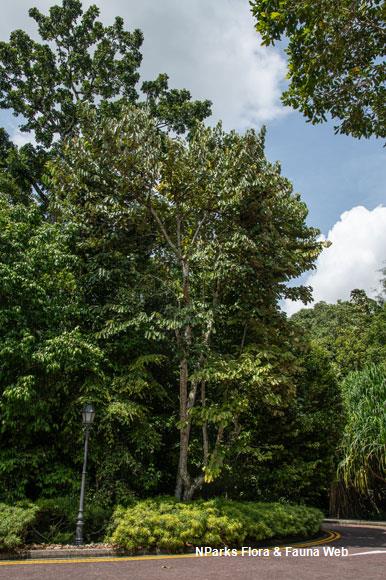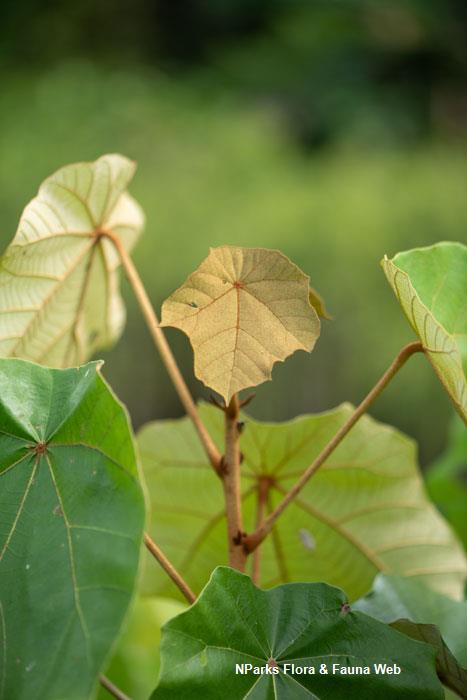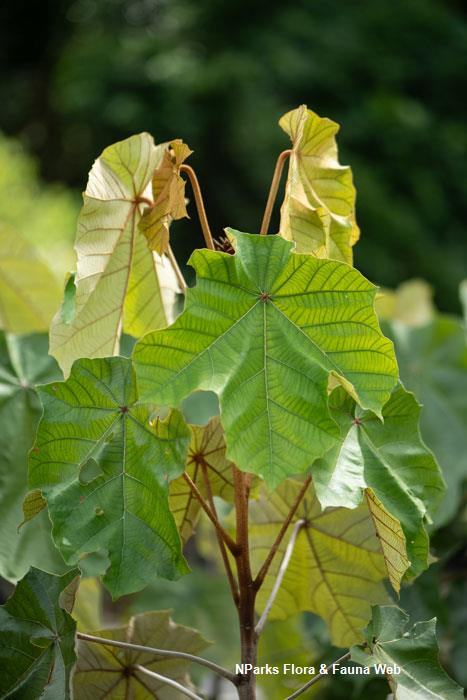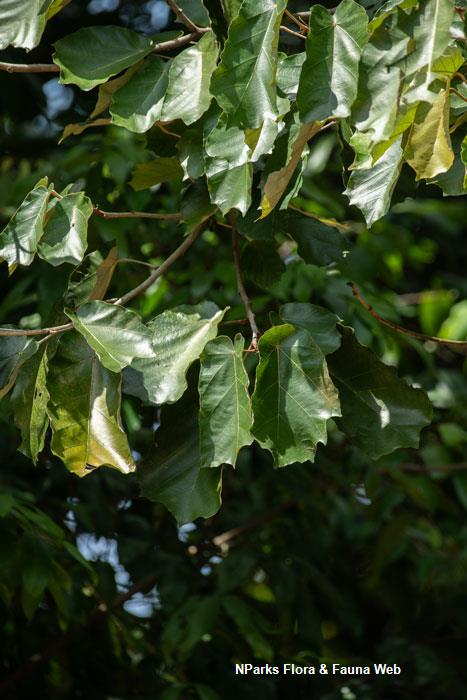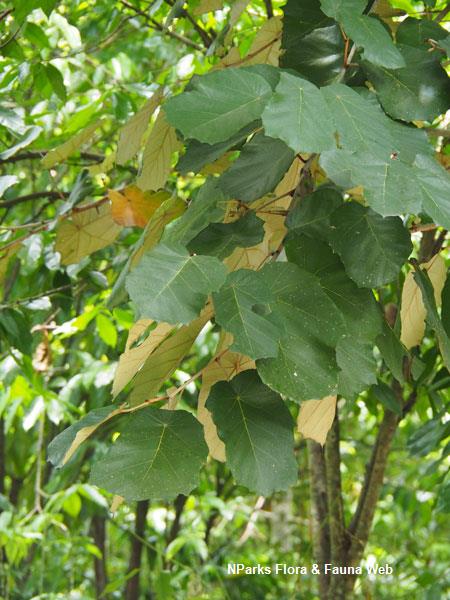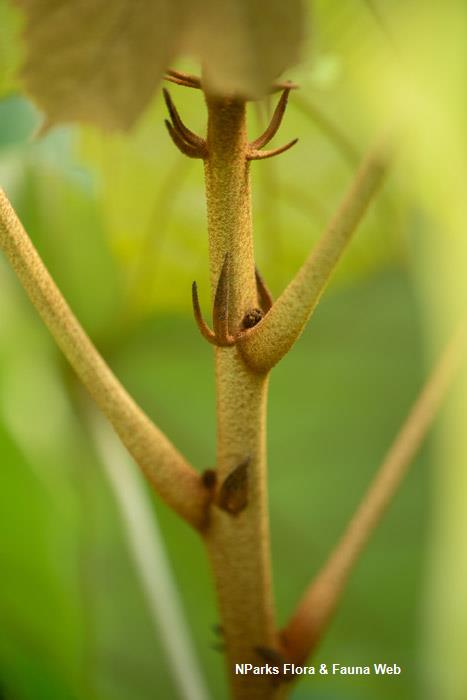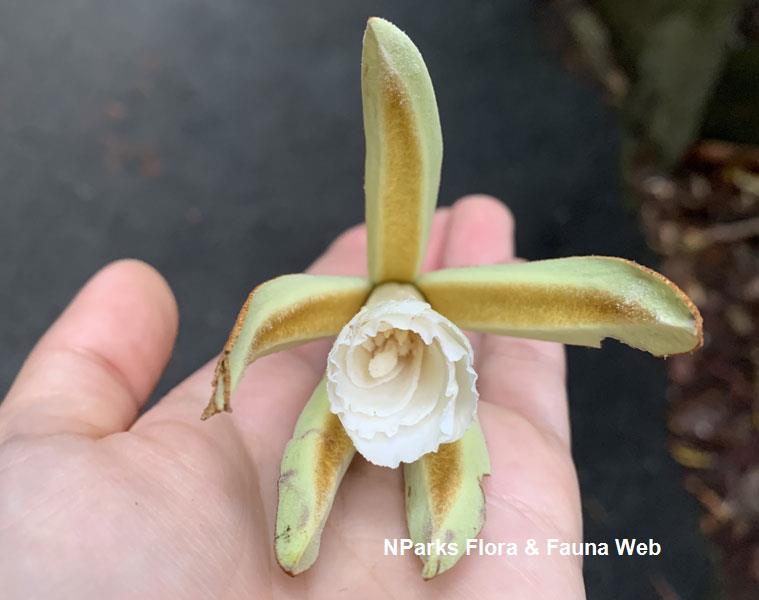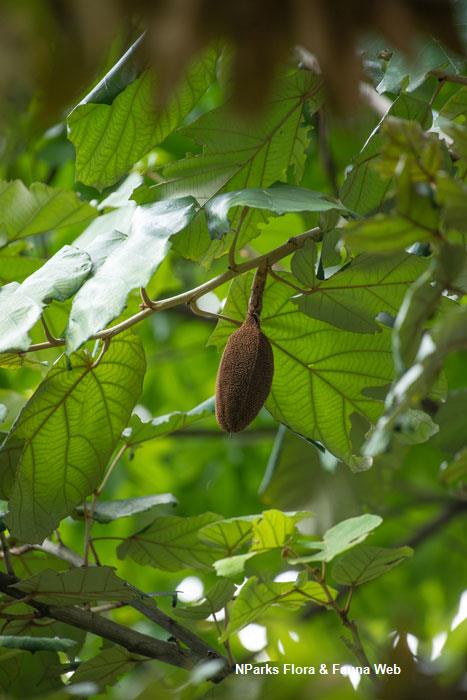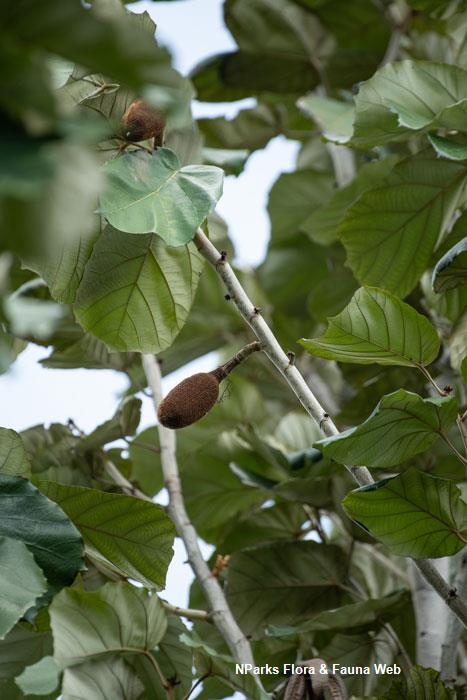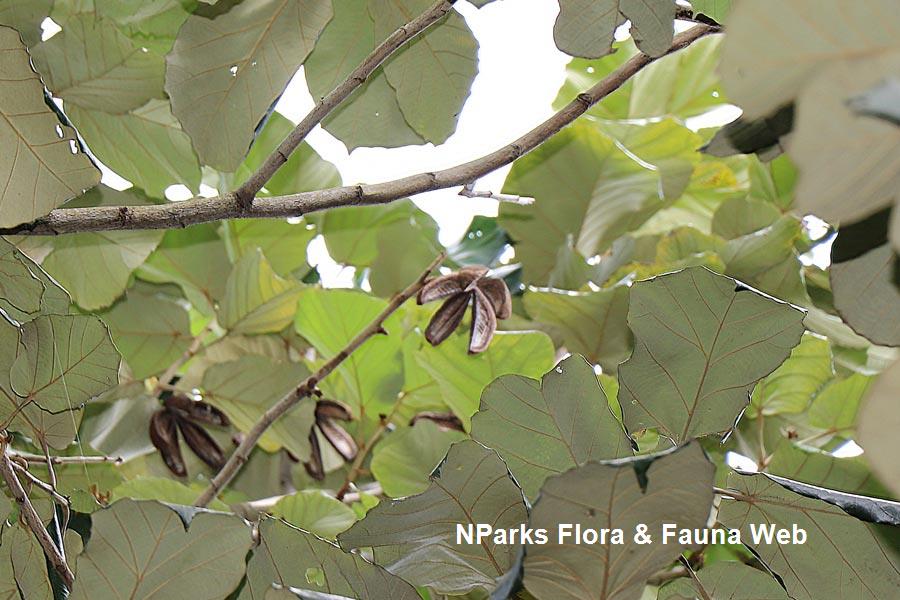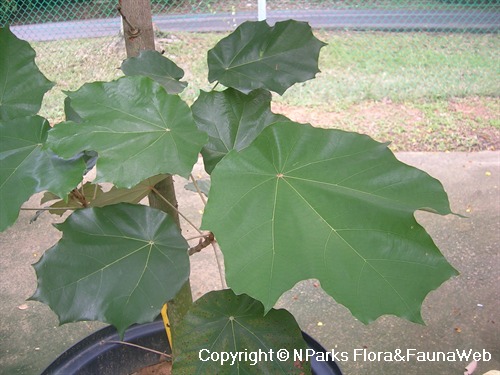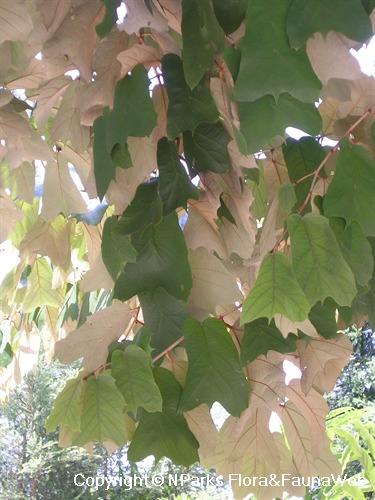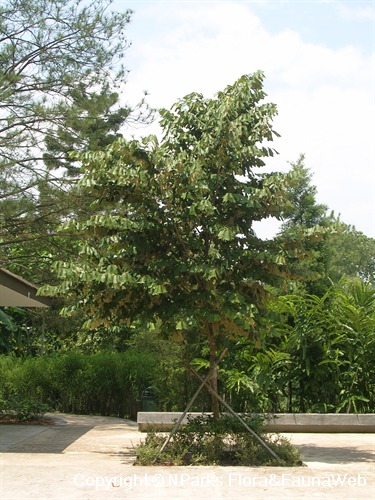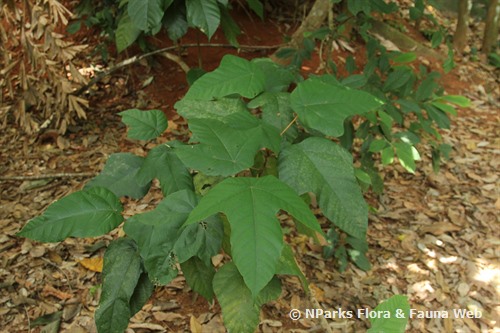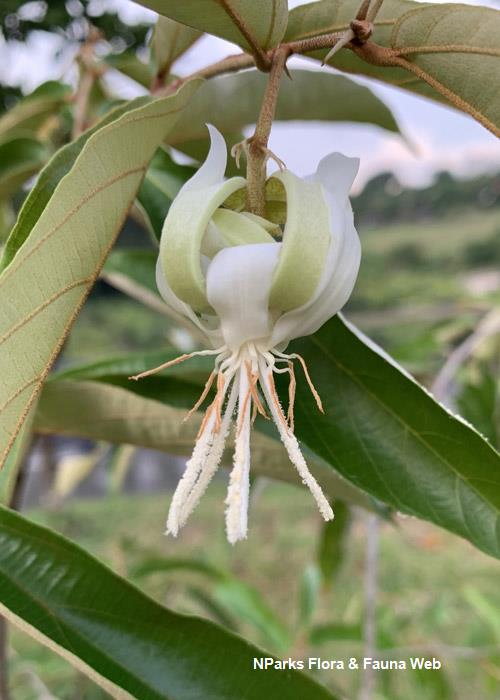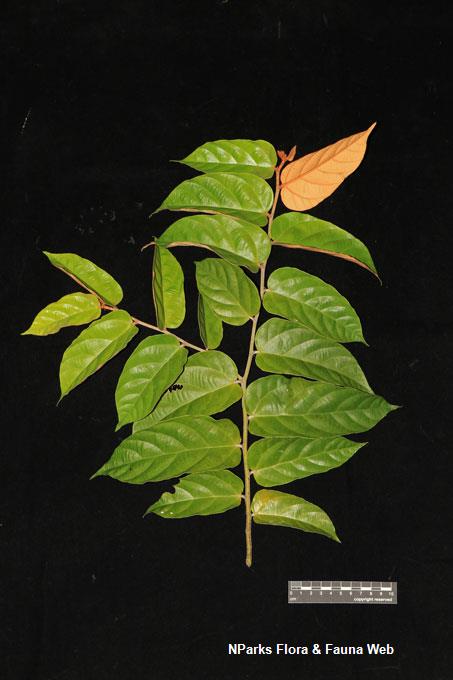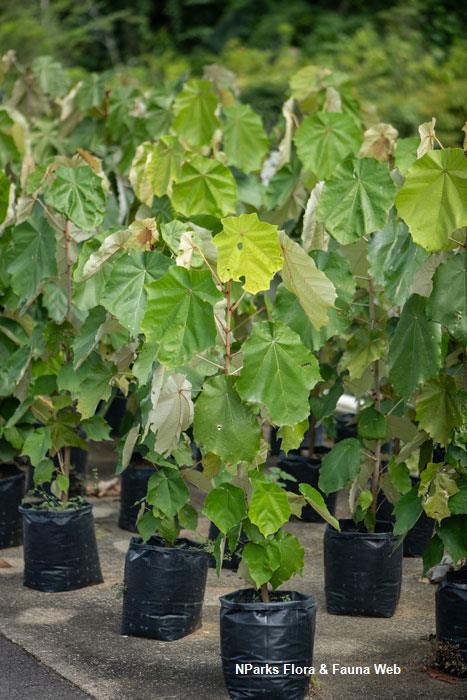
Back
Pterospermum acerifolium (L.) Willd.
| Family Name: | Malvaceae |
| Synonyms: | Cavanilla acerifolia (L.) J.F.Gmel., Dombeya acerifolia (L.) Gaertn., Pentapetes acerifolia L., Pterospermadendron acerifolium (L.) Kuntze |
| Common Name: | Dinnerplate Tree, Maple-Leafed Bayur Tree, 翅子树 |
Pterospermum acerifolium is a tree, up to 30 m tall. The leaves are variable and they can be orbicular, oblong, obovate or even palmately lobed. The upper surface of the leaf is usually green while the underside is yellowish brown and hairy. Prized for its large fragrant flowers, it is cultivated for ornamental purpose.
Name
Classifications and Characteristics
| Plant Division | Angiosperms (Flowering Seed Plants) |
|---|---|
| Plant Growth Form | Tree |
| Lifespan (in Singapore) | Perennial |
| Mode of Nutrition | Autotrophic |
| Plant Shape | Irregular |
| Maximum Height | 30 m |
Biogeography
| Native Distribution | From India to Malesia. |
|---|---|
| Native Habitat | Terrestrial |
| Preferred Climate Zone | Tropical |
| Local Conservation Status | Non-native |
Description and Ethnobotany
| Growth Form | It is a tree which can reach up to 30 m tall and the trunk can reach up to 0.6 m diameter. Bark is grey. |
|---|---|
| Foliage | The leaves are variable. They can be orbicular to oblong to obovate (or even palmately lobed) and can reach 18 – 30 cm long and 14 – 20 cm wide. They are leathery and alternate or spirally arranged. The leaf margin is entire or slightly wavy (repand) or occasionally broadly toothed. The upper surface of the leaf is usually chestnut green (occasionally olive-coloured) and nearly hairless (glabrescent) while the underside is yellowish brown (occasionally white when newly emerged) and densely covered with brown simple woolly hairs interspersed with yellow stellate hairs. Stipules are persistent, about 1.2 – 2 cm long and divided into 2 – 5 parts. The leaf stalk (petiole) is 2 – 5 cm long and covered with chestnut-coloured hairs. The leaf stalk position on the leaf varies from marginal to peltate. When the leaf stalk is marginal, the leaf base is cordate. When the leaf stalk is peltate, the leaf base is rounded. |
| Flowers | Inflorescence occur as a flat-topped cluster (cyme) at the axillary position. The inflorescence comprises of 1 - 3 large white flowers which are fragrant. The flowers are bisexual. Each flower has 5 white petals (10 – 11 cm long), stamens, and an ellipsoid ovary. Sepals are thick, fleshy and densely hairy. They split into 5-parts and curl backwards as the flower opens. |
| Fruit | The fruit is large, woody, angular and spindle-shaped (fusiform), reaching up to 15 cm long and 6.5 cm diameter. They turn dark brown to black and split into five parts when ripe. The seeds are winged and thin, reaching up to 3 – 6 cm long and 1.5 -1.7 cm wide. |
| Habitat | It is found in limestone, mixed dipterocarp and secondary forests, up to 1000 m altitude. |
| Associated Fauna | The flowers could be pollinated by bats. |
| Etymology | Genus epithet ‘Pterospermum’, in Greek, means winged seed, which refers to shape of the seed. Specific epithet ‘acerifolium’, in Latin, means maple-like leaf, which refers to the shape of the leaf. |
| Ethnobotanical Uses | Timber & Products: The wood is used for construction. Others: The tree is prized for its large ornamental and fragrant flowers. |
Landscaping Features
| Desirable Plant Features | Fragrant, Ornamental Foliage, Ornamental Flowers |
|---|---|
| Landscape Uses | Parks & Gardens |
Fauna, Pollination and Dispersal
| Pollination Method(s) | Biotic (Fauna) |
|---|
Plant Care and Propagation
| Light Preference | Full Sun |
|---|---|
| Water Preference | Moderate Water |
| Plant Growth Rate | Moderate |
| Rootzone Tolerance | Well-Drained Soils |
Foliar
| Mature Foliage Colour(s) | Green |
|---|---|
| Mature Foliage Texture(s) | Leathery, Velvety / Furry / Tomentose |
| Foliar Type | Simple / Unifoliate |
| Foliar Arrangement Along Stem | Alternate, Spiral |
| Foliar Attachment to Stem | Petiolate |
| Leaf Area Index (LAI) for Green Plot Ratio | 4.0 (Tree - Dense Canopy) |
Non - Foliar and Storage
| Root Type | Underground |
|---|
Floral (Angiosperm)
| Flower & Plant Sexuality | Bisexual Flowers |
| Flower Colour(s) | Cream / Off-White |
|---|---|
| Flower Grouping | Cluster / Inflorescence |
| Flower Location | Axillary |
| Inflorescence Type | Cyme |
Fruit, Seed and Spore
| Mature Fruit Colour(s) | Brown, Black |
|---|---|
| Fruit Type | Dehiscent Dry Fruit |
References
| References | Ganesan, S.K., Middleton, D.J., and Wilkie, P. (2020). A revision of Pterospermum (Malvaceae: Dombeyoideae) in Malesia. Edinburgh Journal of Botany 77 (2): 161 – 241 |
|---|
Image Repository
Others
| Master ID | 1803 |
|---|---|
| Species ID | 3096 |
| Flora Disclaimer | The information in this website has been compiled from reliable sources, such as reference works on medicinal plants. It is not a substitute for medical advice or treatment and NParks does not purport to provide any medical advice. Readers should always consult his/her physician before using or consuming a plant for medicinal purposes. |

